Archived Blog Posts
Insurance and Water Damage
2/10/2023 (Permalink)
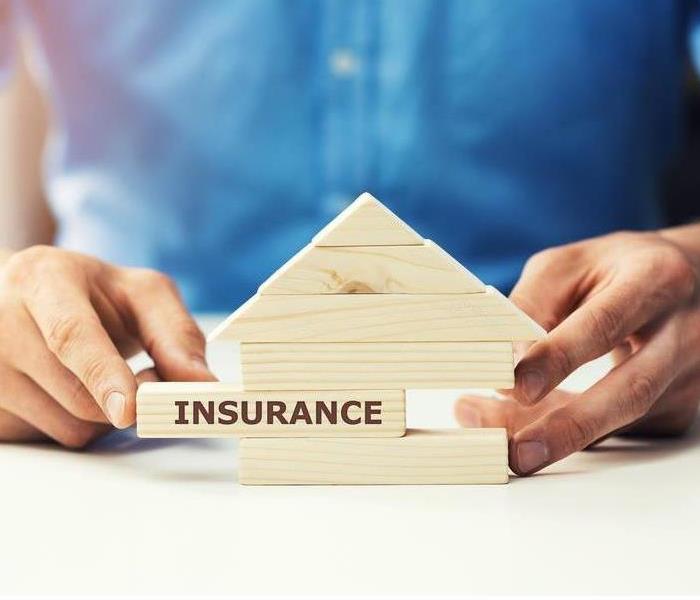 Is your water damage covered by insurance?
Is your water damage covered by insurance?
Water damage is a common occurrence that can occur at any time. When water gets into your home or business, it can cause everything from mild cosmetic damage to expensive structural damage. Your insurance policy may cover some types of water damage, but there are many types of water-related incidents that aren't covered by standard policies. Knowing the difference between what's covered and what isn't can help you prepare for any eventuality.
What’s Covered?
If you have suffered from any type of water damage, whether it's from floods, burst pipes or frozen pipes, you may be eligible for coverage under your homeowners insurance policy. Flood waters and storm damage can affect your entire house.
Sewer backup is also a common problem coming from a clogged drain or a cracked pipe. Water can collect in your house basement without proper drainage. If sewage backs up into your home, you need to call a plumber immediately. Most homeowners and renters insurance policies cover sewer backups caused by septic system failure or backed-up municipal sewers.
Some water damage falls into an insurance "gray area."
Some water damage falls into an insurance "gray area." While your policy may cover some types of water damage after an accident, it may not cover damage caused by lack of maintenance in your home or apartment. For example, if you forget to clean out your gutters in the fall, your roof and eaves may not be able to withstand the burden of snow and ice during the winter. This could cause water damage — but it's not accidental, and so it would not be covered by your insurance policy.
That being said, don't worry too much about these kinds of things! Insurance companies have plenty of experience dealing with claims like these--you'll probably get plenty of help navigating them from them when they come up!
Having home or business serviced by professionals that are certified both in remediation (restoration industry standard) and reconstruction will help ensure complete coverage from floor to ceiling as well as outside grounds or lot.
SERVPRO in Ebensburg is locally owned and operated and IICRC certified for water damage restoration and building construction & restoration. Being certified is important because it ensures you're working with professionals who are trained in the most up-to-date methods and techniques. You can also rest assured that your property will be restored to its preloss condition, which means that if you want to sell your home or business at some point in the future, you'll have peace of mind knowing it will look just as good as it did before water damage happened. IICRC certification isn't just about making sure customers get high quality workmanship, it's also about protecting their investment by ensuring they receive full coverage under their insurance policy. As a result, when choosing a restoration company for any type of water damage clean up job - whether residential or commercial - make sure they're certified by asking them directly!
If you are looking for a water damage restoration company, SERVPRO of Ebensburg is here to help. We have been providing quality service to our community and we have the knowledge and experience needed to make sure your property is restored back to normal as quickly as possible. For more information, give us a call today!
A Serious Problem: A Leaky Roof
1/23/2023 (Permalink)
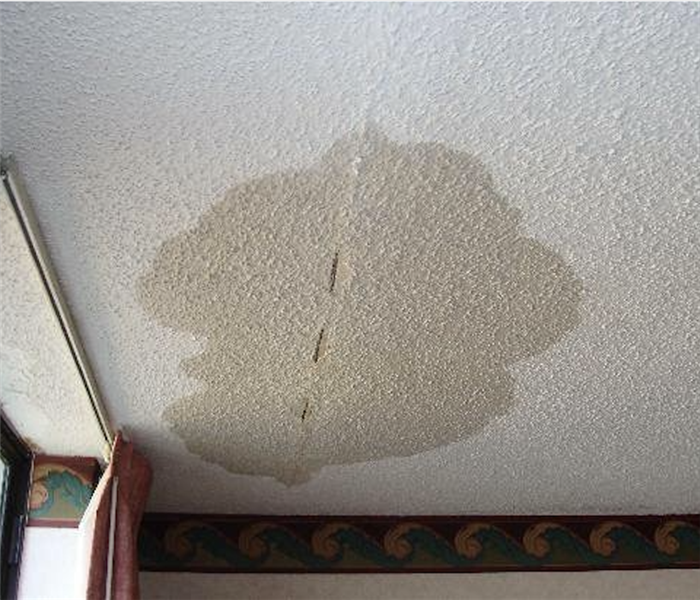 If you suspect that your roof is leaking or has developed a leak, give us a call today!
If you suspect that your roof is leaking or has developed a leak, give us a call today!
A roof leak is when water enters your home through the roof. While it may not sound serious, a roof leak can lead to mold and other potential hazards. Roof leaks are commonly caused by damaged and missing shingles, missing or worn-out flashings, and improperly flashing windows or skylights. Regardless of the reason for the roof leak, the leak can lead to mold, which can be problematic for the structure of the home.
How to Tell If Your Roof Is Leaking
To determine if your roof is leaking, here are some things to look for:
- Discoloration of the ceiling and/or walls. This can be caused by water that has run down a wall or dripped on a surface.
- Damp spots on ceilings or walls. If you are able to locate damp spots, use an absorbent cloth to dab up any remaining moisture from these areas.
- Water stains on ceilings and/or walls (indicates prolonged wetness). If you see water stains, look for additional signs of leakage such as discoloration in those areas. Water stains may also indicate mold growth behind drywall where it's difficult to access without damaging interior surfaces such as drywall and flooring.
Roof Leaks and Mold
Mold can cause structural damage to your roof. This means that mold is eating away at the wood and other material in your roof, causing it to rot. Mold can also cause a roof leak. If you find mold growing around where water collects on your roof, there's a very good chance that this is what caused the leak in the first place. Molds are also notorious for being able to eat through tar paper and shingles as well as some other types of materials used for roofs; if you see any type of discoloration or peeling on these surfaces then there's probably mold underneath those areas too!
Preventing Mold
Keep your roof clean. It's a good idea to have someone conduct an inspection of your roof every year, especially if it's made of a material that can easily become moldy (like wood). Make sure there aren't any leaks in the attic or other areas of the home. If you find one, get it fixed right away!
Clean out gutters and downspouts regularly so that water flows freely from them. This will help prevent water from pooling on the roof and leading to mold growth.
If possible, insulate your attic to keep moisture levels low inside of it. If you live in an area with high humidity during certain times of year—like summer—you may want to consider using a dehumidifier while sleeping or spending time indoors during these months as well; this will help keep air circulating freely throughout your home instead of trapping moisture inside walls where it might cause problems later down the road!
Talk to an expert about your roof's overall condition.
The best way to figure out if you have a mold problem on your roof is to have an expert inspect it. Make sure that you hire someone who can take samples of the mold and evaluate them for potential health risks. If there are any signs that the mold could be toxic, call in professionals who specialize in cleaning up contaminated buildings, like SERVPRO of Ebensburg, as soon as possible.
While leaks in your Ebensburg home can be a source of stress, it’s important to remember that you don’t have to deal with them alone. Our expert team is here to help! If you suspect that your roof is leaking or has developed a leak, give us a call today!
What is IICRC?
11/30/2022 (Permalink)
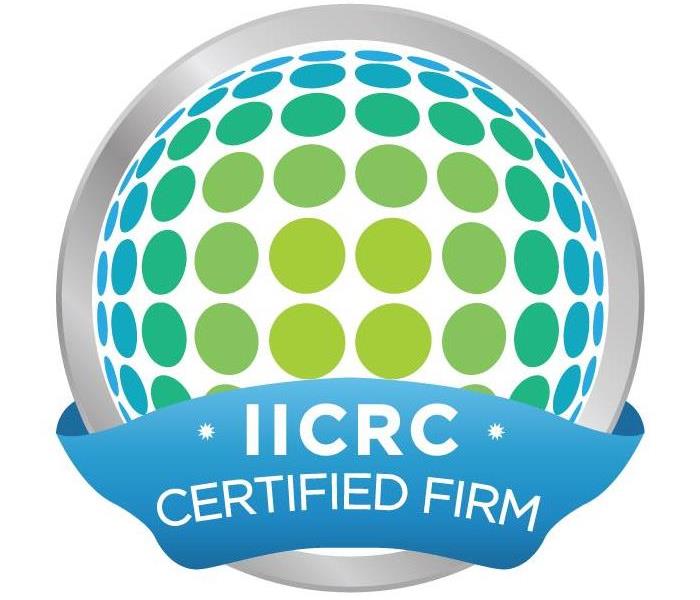 SERVPRO of Ebensburg is proud to be an IICRC Certified Firm!
SERVPRO of Ebensburg is proud to be an IICRC Certified Firm!
Institute of Inspection, Cleaning and Restoration Certification or IICRC is an organization dedicated to protecting the environment, homes and businesses through professional restoration services. The IICRC has certified individual technicians and firms who meet industry standards of knowledge and skill. Firms and technicians are required to maintain the IICRC's stringent qualifications to retain certification with ongoing education. These programs are designed to educate and improve the restoration industry every year.
IICRC is a professional certification body.
The IICRC has been around for 50 years, and the organization's goals are to protect the public from injuries caused by water damage, mold remediation, and other building related issues. The IICRC provides training and education to its members. It also offers certification for members who successfully complete certain levels of training in their field as well as for those who have reached a certain level of experience in their field.
The Institute certifies individual technicians and firms that have met industry standards of knowledge and skill through continued education to keep their training up-to-date.
IICRC promotes education and improving techniques.
IICRC certification is the gold standard of commercial cleaning and restoration industry professionals. These programs are designed to educate technical professionals regarding new technologies and improve techniques regarding communication with customers, insurers, and other professionals. Having an IICRC certified firm also increases employee retention rates, deters litigation through education and promotes market credibility.
IICRC certification is a mark of quality that you can count on. If you’re looking for a safe and reliable company to handle your water damage restoration needs, look no further than SERVPRO of Ebensburg. Our team is proudly IICRC certified to ensure thorough and safe restoration services. We are here to safely support and restore our Ebensburg community.
What Are the Three Different Kinds of Contaminated Water?
11/8/2022 (Permalink)
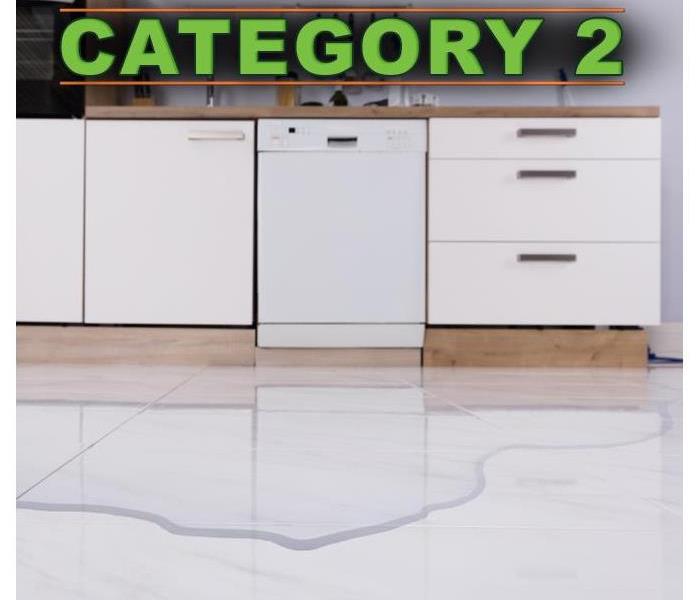 A spill from the dishwasher could be considered Category 2
A spill from the dishwasher could be considered Category 2
What Are the Three Types of Contaminated Water?
An emergency water damage event can be devastating to the home or business and sometimes it’s not possible to avoid it. If you have a flood, it’s important to know who to call and when.
It’s important to know the difference between the three types of water contamination. If you don’t, you could end up with a bigger problem than you expected.
There are three types of water contamination: biological, chemical, and radioactive contamination.
Each type requires different steps for treatment and cleanup so it is important to know how to recognize each one if you find yourself working in an area where contaminated water may be present.
Biological Contamination is caused when there are living organisms in a body of water or liquid (like milk or juice). These can include bacteria, viruses, parasites like worms and amoebas which make people sick if they get into their bodies through food or drink that contains them; therefore this type can occur anywhere that humans live near water sources such as lakes and rivers but it's most common at large-scale events where thousands upon thousands of people attend without proper sanitation facilities nearby like bathrooms/toilets etcetera - because then they have no choice but use whatever source they have available nearby instead - which often leads
Category 1 - Clean Water
Unsanitary water sources known as Category 1 (clean water) would be from a clean supply line, such as your sink or bathtub. This is called category 1 water. It is safe to use for cleaning and washing, but it is not recommended for drinking due to the lack of purification treatment.
Category 2 - Gray Water
Category 2 (contaminated) is gray water. Gray water can be discharged due to a dishwasher, washing machine flood, or even an overflowing toilet that only contains urine.
Gray water is not safe to use for drinking or cooking because it may contain some dangerous chemicals or components:
- Fecal coliform bacteria and other organisms from human waste
- Chemical pollutants used in laundry detergents, household cleaners, and personal care products such as shampoo and soap
Category 3 - Black Water
Black water requires special attention because it often contains harmful bacteria and pathogens. It's called black water because it is not clean, and it should never be ingested. If you've found yourself in a situation where your home or business is flooded with this kind of water, you need to call the professionals at SERVPRO of Ebensburg immediately and avoid the area.
If you find your Ebensburg, PA home or business flooded with any kind of water — you need professionals on the job to take care of the mess and restore your home or business to its original, preloss condition. SERVPRO of Ebensburg is here to help make that process as easy and painless as possible. Give us a call!
What Can Expect After a Partial Loss?
10/11/2022 (Permalink)
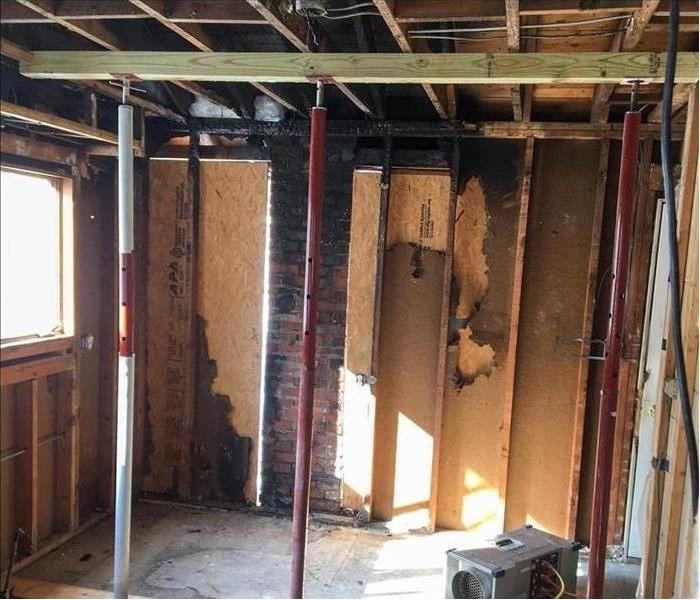 Our technicians are trained in fire and water damage restoration.
Our technicians are trained in fire and water damage restoration.
Everything You Need to Know About Partial Losses
A partial loss can be confusing and can take more time than a total loss. However, it is also an opportunity for improvement and positive change for your business. You may want to consider updating your insurance coverage or security system as a result of this experience.
A partial loss can seem like more work than a total loss, but SERVPRO of Ebensburg can help. We have the resources and expertise to take care of your home or business after a fire. Here are some common questions we hear from our customers:
What has to be cleaned up?
- Structural damage: The structure may be damaged by fire and smoke, which can cause the walls to bow, the roof to sag or collapse, and even the foundation to crack.
- Cleanup: If this is a partial loss, you will need to remove all contents from your home so they can be cleaned, deodorized, and stored until it’s safe for them to come back inside. Some items may be salvageable while others might not.
- Carpets: A carpet that has been drenched with water (and possibly exposed to smoke) will need replacement if it was an expensive one or if its color or pattern is important. You may want to consider replacing all of your carpets after a fire—even those that were not damaged—for reasons of appearance and safety; they really don't look good when they've been soaked with water!
What happens to the contents of my home or business?
All contents will be inventoried and moved to a safe place to be cleaned, deodorized, and stored until the structure is ready for them. Once the fire has been extinguished, your property manager or adjuster will walk through with you to see what can be saved. They'll take photos of any damage so you can review it later. If there's any question about whether something was damaged by the fire or whether it's been stolen, an inspection report from an expert should clear things up for you.
Can I clean my carpets?
Carpeting can be cleaned or replaced. If you have a partial loss, your carpet will likely have to be cleaned and deodorized as a result of smoke damage. You’ll want to hire a professional to do this. If the damage is too severe for cleaning alone, however, carpets may need to be removed entirely and replaced with new ones.
Carpets should also be dried using fans and/or dehumidifiers after they've been cleaned. The moisture in wet carpets can cause mold growth if left untreated—and once mold sets in on your property—it's extremely difficult (if not impossible) to get rid of completely!
What about the electrical outlets in my home?
Electrical outlets and light switches often sustain damage in fires, so replacing these items is a good idea for safety purposes. However, it's also important to note that this job can be very time-consuming.
The wiring in your house may have been damaged by water or smoke as well as heat. If this is the case, installing new wiring will be necessary to restore power to your home—and it will be even more time-consuming than simply replacing electrical outlets and light switches!
If you’re an owner of a business, you may have some questions about what to expect after a partial loss. This happens when only a portion of your building is damaged in comparison to the total loss. While this can seem like more work than a total loss, SERVPRO of Ebensburg can help!
The best way to restore your home after a partial loss is to call SERVPRO of Ebensburg. We can help you with all stages of the restoration process, including clean-up, deodorization, and repairs. Our technicians are trained in fire and water damage restoration so they know exactly what they are doing when they arrive on the scene.
The 4 Leading Causes of Home Fires
8/27/2022 (Permalink)
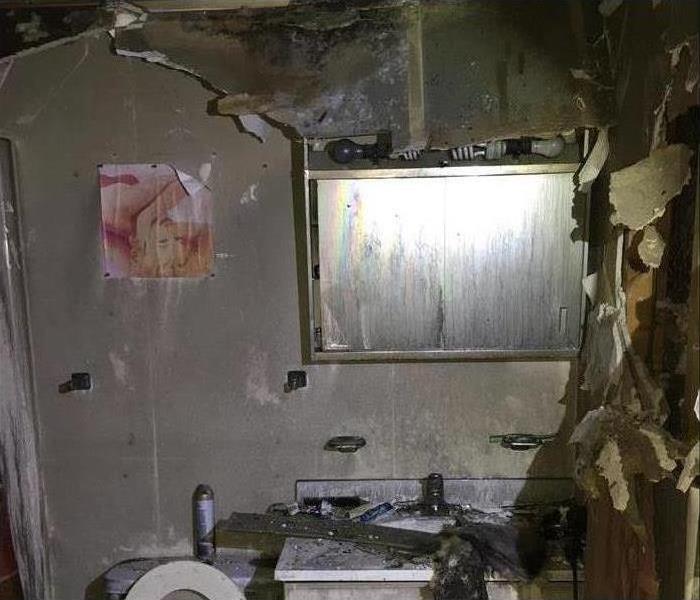 House fire in Ebensburg, PA
House fire in Ebensburg, PA
The Top Four Home Fire Causes
Fire statistics in the U.S. paint a picture of a disturbingly common problem. According to the National Fire Protection Association, a fire breaks out somewhere in the nation every 24 seconds. While progress has been made over the years, a home fire still happens frequently. Most of the fires are preventable with common-sense precautions. The leading causes of a fire show people often make unwise choices in their homes.
1. Cooking Fires - When it comes to fire causes in homes, this is among the most common fires. In addition to causing about 550 deaths a year, these fires account for about $1 billion in property damage. This type of home fire spikes around the holidays of Thanksgiving and Christmas.
2. Candle Fires - While candles can be soothing, they can also be dangerous. About 21 candle fires are reported every day in the U.S. December and January are the peak months for this fire type. They cause a higher amount of property damage than many other fires.
3. Home Grill Fires - This type of fire accounts for about 10,600 home fires each year. Though home grill fires do not cause a lot of deaths, they still cause a lot of damage to home structures.
4. Electrical Fires - This type of fire is caused when electrical systems malfunction. They are most common in old weather months. Electrical fires are often caused by arcing, and they result in many deaths and significant property damage every year.
A home fire is a devastating event for many families. To help people cope with the aftermath of a fire, a local fire remediation franchise in Ebensburg, PA, is often the best resource to aid in recovery. The technicians are experts in fire cleaning, and they can deal with both the effects of structural damage as well as smoke damage. The technicians can also offer excellent advice on fire precautions and avoiding a fire in the first place.
3 Possible Consequences of Hidden Water Leaks
8/27/2022 (Permalink)
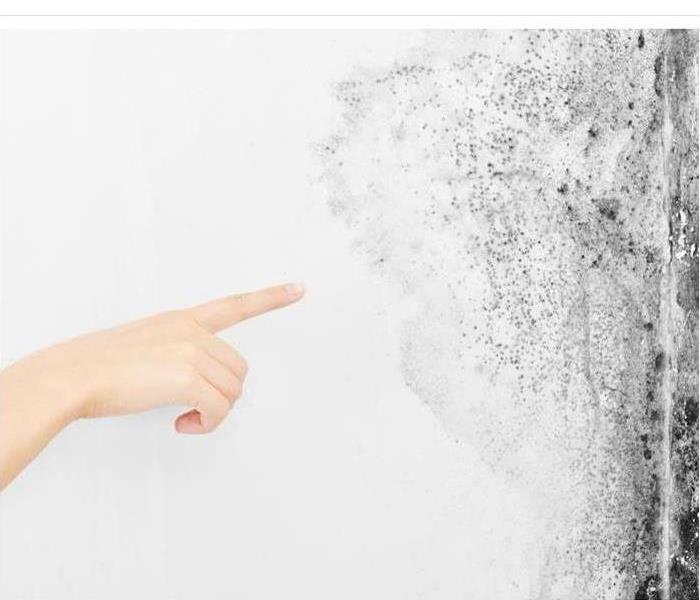 The incursion of unchecked water also promotes the growth of mold and mildew
The incursion of unchecked water also promotes the growth of mold and mildew
Keep An Eye Out For Any Sign Of It
While a sudden tide of water sweeping through a building and its negative impact on said structure is quite noticeable, not all sources of water damage are so easily detectable. Broken pipes in walls with thin cracks or leaky fittings that just barely allow trickles of water to escape gradually, for example, may go unnoticed for quite some time. By the time they have been discovered, the resulting consequences and the water cleanup required may be quite extensive, requiring a professional cleanup and restoration service in Belsano, PA, to deal with.
1. Building Damage
Moisture can cause water damage and compromise the structural integrity of the commercial property. Examples of harm it may cause to buildings include:
- Peeled paint
- Stained wallpaper and walls
- Rotten and weakened wood
- Rusted/corroded metal
It may also affect contents like inventory.
2. Mold, Mildew, and Pest Invasion
The incursion of unchecked water also promotes the growth of mold and mildew, both of which thrive in wet environments. Mold and mildew also eat away at construction materials as they spread, causing further structural deterioration. They are also unappealing to clients and customers when they spread from out of sight locations to more visible ones, possibly costing some establishments business. The erosion of wood from the wetness also invites pests to burrow into the softened ceiling and walls.
3. Increased Utility Expenses
There is also often a spike in utility bills associated with undiscovered leaks. The cost of water goes up as liquid drips unnoticed from broken pipes. The price of heating and air conditioning may also see a rise in cases where insulation has been damaged, causing HVAC systems to have to work harder. Higher humidity in the air also correlates to more strain on air conditioning units.
Water damage is not the only less than pleasant repercussion that may arise from a hidden leak. Neither are the ones listed here all that may occur. There are many less than positive likelihoods that may happen because of unfound leaks, so it is important to keep an eye out for any sign of one.
Identifying and Remediating Mold
8/10/2022 (Permalink)
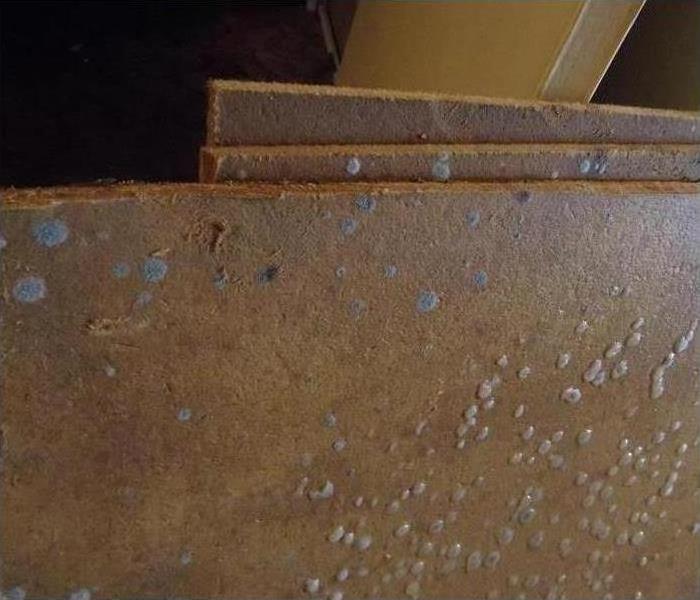 Mold can be found anywhere
Mold can be found anywhere
Take The Right Steps To Remediate Mold
Mold is found everywhere, both indoors and outdoors. While most species of mold don’t present a problem, it will multiply if given the ideal environment of moisture and oxygen. Fortunately, there are mold remediation specialists available to take care of any mold situation. If you suspect that your Belsano, PA, business has black mold, it’s important to take the right steps to remediate the problem.
Identification
Most people have heard horror stories of mold. Regrettably, sensational news stories only impair the goal of helping people understand mold. Here are some basic facts about mold:
- Mold spores are common inside and outside
- Mold grows in places with high moisture
- Mold enters buildings through windows, vents, and HVAC systems
- Mold may produce a musty odor
Additionally, there are thousands of species of mold in a variety of colors. Thus, it is often difficult for individuals to tell if they have a mold problem. To prevent mold infestations, business owners should regularly inspect their property. Check around windows, heating and air conditioning systems, roofs, basements, and pipes. To identify what specific type of mold is in your building, such as black mold, you will need the help of an Indoor Environmental Specialist.
Remediation
The first step in remediation is finding the source of moisture. A leaky roof, faulty plumbing, flooding, and high humidity are common causes of moisture. A mold remediation specialist will inspect the building and assess the damage. Next, the specialist will contain the mold using advanced procedures and tools. Once the mold spores are contained, air filtration equipment is used to capture the spores and eliminate mold colonies. The final step in remediation is cleaning and restoration.
Business owners should be aware of the signs of black mold in order to prevent major problems. If you see or smell any signs of mold, get professional help for proper mold cleanup.
How To Protect Your Home From Winter Storms
7/27/2022 (Permalink)
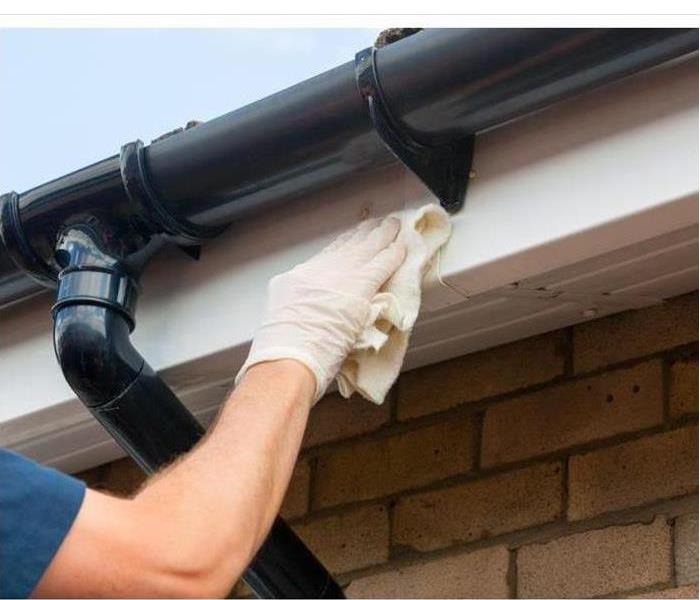 Keep your gutters clean
Keep your gutters clean
These Simple Steps Can Help Protect Your Home From Damage
It's no secret that a winter storm can wreak havoc on your home, but a few simple steps can help you protect your home from damage.
Have Supplies on Hand
When a winter storm hits, it's not always safe to go buy the things you need. That's why it's best to keep an eye on the forecast and make sure you have all the supplies you require before a storm occurs. You will need:
- Food
- Drinking water
- Snow shovel
- Flashlights and batteries
- Generator or firewood
- Warm clothing and blankets
Seal Air Leaks
Air leaks, such as extra space around doors, allow warm air to escape from your home. This will make it harder to heat your home, increasing energy costs. Seals can be applied to doors, windows, and other areas to keep the warm air in and the cold air out.
Keep Trees Trimmed
Cold temperatures and the weight of snow and ice can cause tree branches to fall. Trimming branches that could fall onto your house or vehicles can help prevent roof damage, car damage, and injury. It is also a good idea to cut off any loose or dying branches before a storm regardless of location.
Clean Gutters
Having blockage in your gutters can cause ice dams. These dams can prevent water from exiting your gutter normally and can push it under the roof, which can cause leaks and roof damage.
React Quickly
If your home incurs any damage, it is best to call an emergency restoration service immediately. You may hesitate to call if a blizzard is still ongoing, but not addressing the damage leaves your home vulnerable to additional damage.
A winter storm can be dangerous and cause damage to your home, but you can keep yourself and your house safer by having supplies on hand, sealing air leaks, trimming tree branches, cleaning gutters and reacting quickly.
Cleaning Up an Overflowing Toilet
7/19/2022 (Permalink)
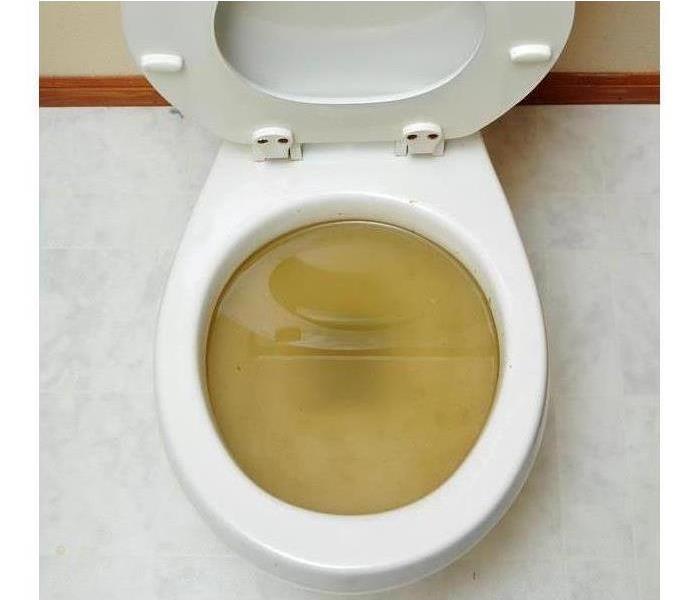 An overflowing toilet is a disastrous sanitary issue that can potentially cause massive amounts of damage
An overflowing toilet is a disastrous sanitary issue that can potentially cause massive amounts of damage
Follow The Steps Below If You Have An Overflowing Toilet
An overflowing toilet is a disastrous sanitary issue that can potentially cause massive amounts of damage. Preventing the sewer damage from reaching other areas of your house is key to keeping damage at a minimum. Quickly follow the steps below if your home in Belsano, PA, has an overflowing toilet.
1. Stop the Overflow.
Lift the lid from the back of the flooded toilet and press down on the rubber valve to close the tank. Then lift the float to stop more water from entering the toilet bowl. Turn the valve at the back of the toilet clockwise to completely shut off the water supply.
2. Mop Up the Spill.
Quickly mop up the standing water on the bathroom floor to prevent liquid sewer damage. Once you finish, wring the mop out into an empty bucket.
3. Unclog the Toilet.
Try using a plunger to dislodge the clog first. If this doesn't work, you can opt to use a closet auger instead. To do this, insert the auger so the curve of its tip faces the same direction as the drain. Crank the auger as far as you physically can in both directions to dislodge the clog. Carefully pull the auger out before switching back to a plunger. If these steps aren't successful, call a plumber.
4. Discard the Toilet Waste.
If, and only if, you were successful in Step 3, pour the contents of the mop bucket back into the toilet and flush. Use hot water to rinse and clean the mop and the bucket.
5. Sanitize the Area.
Create a cleaning solution using a gallon of hot water, and 1 cup of bleach. Use this solution to scrub and sanitize any area that came into contact with the toilet water. Wear rubber gloves to protect your skin during this process.
Sewer damage caused from toilet overflow can wreck havoc on your residential bathroom. After you finish cleaning the bathroom, you need to contact either a sewage company or water remediation professionals to help resolve the damage.
Why Your Water Heater Is Making Noise
7/12/2022 (Permalink)
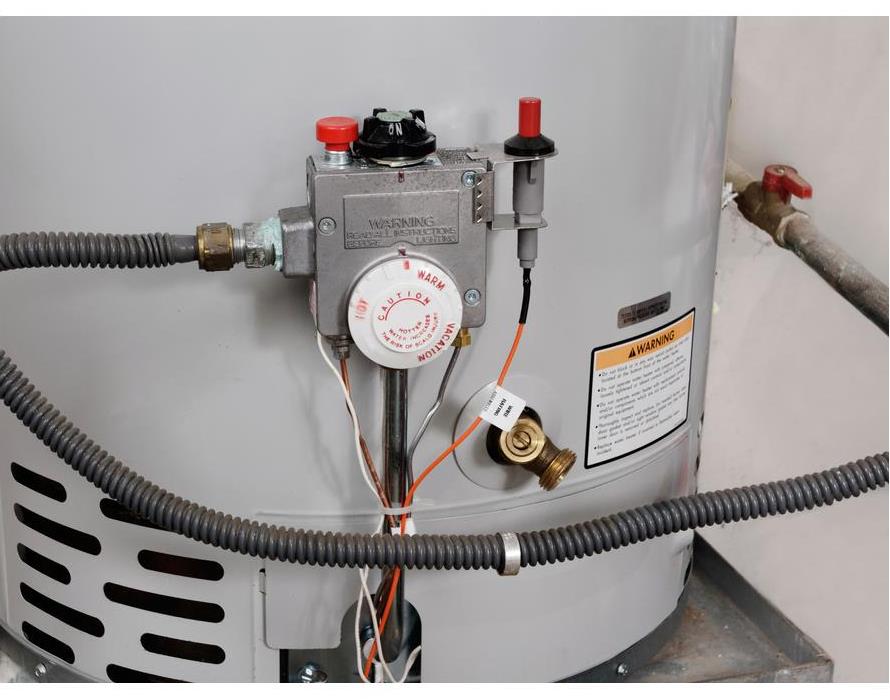 What does it mean when your water heater starts making mysterious noises?
What does it mean when your water heater starts making mysterious noises?
Why Is Your Water Heater Noisy?
Your water heater may have started as a strange popping sound and eventually progressed to popping plus an ominous rumble. What does it mean when your water heater starts making mysterious noises? While loose elements and heat traps can account for some of the sounds you may hear, the most likely explanation is that you have sediment build-up inside your tank and it’s time to call a professional in Vinco, PA, to flush them out. Ignoring sediment build-up can lead to serious problems, such as:
- Decreased energy efficiency
- Sediment coming out of faucets
- Decreased water pressure
- Burst water pipes
- Water heater failure
Many manufacturers recommend getting a water heater flush every year, but how often it actually needs to be done depends on the water in your region.
What Causes the Noise?
When sediments collect around the element, they can trap water below them. When the water is heated, it makes a popping or crackling noise as it bubbles up through the sediments. As more sediment collects, it can get mixed around by the water flow inside your tank, causing a rumbling sound. If you notice these or other unusual sounds, especially when you haven’t noticed them before, it’s an indication that your tank needs to be serviced.
Where Does Sediment Come From?
Most sediment build-up is a result of minerals found in the water supply. If you have hard water, lime deposits build up in your tank over time, creating a sediment layer on the bottom that interferes with heating the water inside the tank. In some areas, the municipal water supply carries sediment in it, and this can also build up in your tank.
If you’re not sure what water quality is like in Vinco, PA, it’s better to err on the side of caution and have your water heater flushed annually to avoid the damage sediment build-up can cause.
Fix the Aftereffects of Bursting Pipes in 5 Simple Steps
6/30/2022 (Permalink)
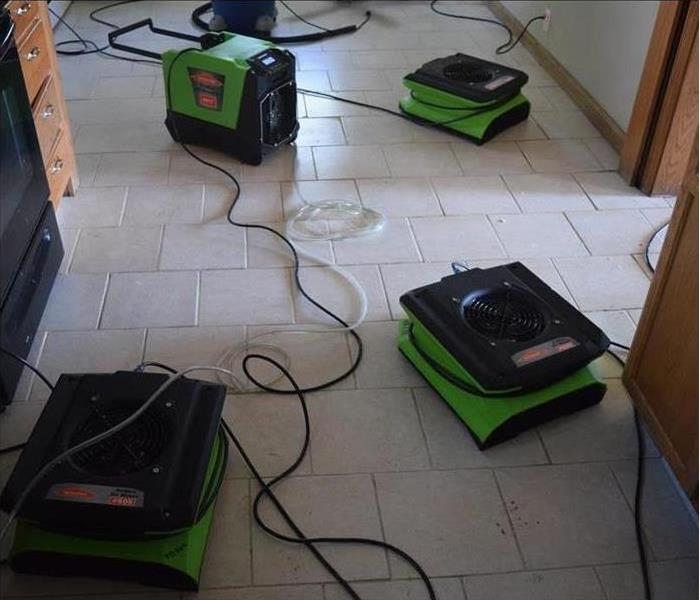 Water damage cleanup in Gallitzin, PA.
Water damage cleanup in Gallitzin, PA.
In 5 Easy Steps, Resolve the Consequences of Bursting Pipes
Bursting pipes can cause flooding and damage in your Gallitzin, PA, business. If the water isn't swiftly dealt with, problems such as mold and structural deterioration can arise. Follow these simple steps to begin the cleanup process and prevent further damage.
1. Cut Off Electricity and Water
Cut off all water to the problem area. If you don't have access to water control, immediately contact the person who does. You should also shut off electricity to water-affected areas. But don't touch or approach electrical equipment already exposed to water, as it may produce an electric shock.
2. Hire Professional Help for Bursting Pipes
Contact commercial building restoration experts to initiate water removal and prevent secondary damage such as mold. The restoration team will assess the damage and form a plan to help restore your business to its pre-flood condition. Hiring a professional plumbing service to fix broken pipe issues is also recommended rather than attempting to fix them yourself.
3. Avoid Unsafe Areas
Broken pipes may cause flooding and water-logged ceilings or floors. Do not enter these areas, as they may collapse and cause injury.
4. Protect Furniture and Appliances
Protect furniture legs from water-damaged flooring by placing wooden blocks or aluminum foil beneath them. Electronics and water-sensitive objects such as paintings should be stored in a dry place away from flooded areas.
5. Remove the Water
Removal of water damage is best left to professionals. Enlist the services of water mitigation experts to help safely and efficiently return your business to its pre-damaged condition using pumps and other specialized equipment. While you wait for experts to arrive, use towels or mops instead of vacuums to remove water from floors. Electronics, especially those connected to an outlet, are more likely to deliver an electric shock when exposed to water.
Flooding from busted pipes may cause structural damage, odors, and even mold if not quickly resolved. Follow these guidelines to start confidently resolving the aftereffects of bursting pipes.
What Is Involved With Roof Damage Mitigation?
6/14/2022 (Permalink)
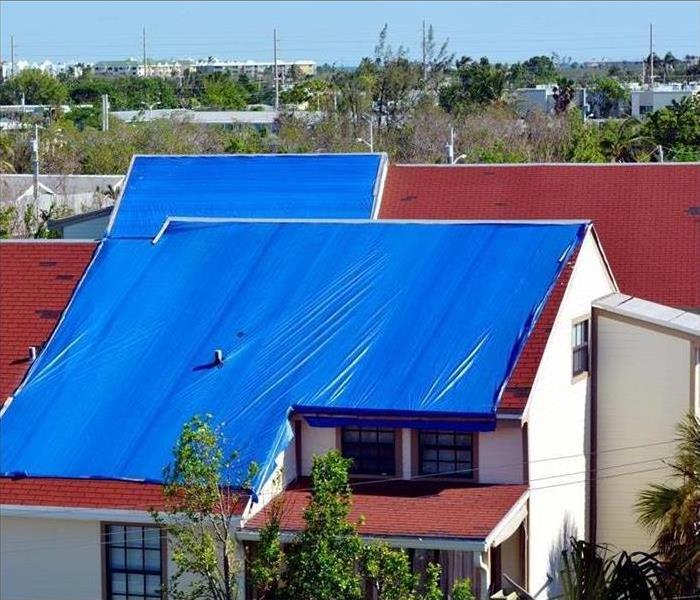 Mitigation repairs may include: tarping over the area of the roof.
Mitigation repairs may include: tarping over the area of the roof.
After a severe storm in Summerhill, PA, there is a good chance your home has sustained roof damage. When that rain and wind damage has created areas of exposure on your roof, it leaves an opening for additional damage to happen, such as mold growth. If that happens, there is a good chance that those needed repairs won’t be covered by your insurance provider.
What Does Roof Mitigation Look Like?
After filing a claim, your insurance company will likely require you to take temporary measures to mitigate damage. These mitigation repairs may include:
- Covering cracked or broken skylights and windows with plastic.
- Tarping over the area of the roof that is leaking.
- Placing a tarp over any siding that is loose or missing.
- Removing a downed branch and tarping over the damaged area.
The sooner these temporary repairs are done, the chances improve that additional damage will be avoided. If it is not possible to make these repairs yourself, certified water and mold damage companies often include tarp services.
Roof Damage Prevention
While maximizing your claim may be the most obvious reason to take mitigation measures, protecting your home is the ultimate benefit. From more bad weather to critters, any exposed areas open the door to additional damage. When that happens, it means paying out of pocket for repairs. Although you may not be able to avoid bad weather, there are ways to minimize damage to your roof. These include:
- Check the attic for signs of leaks
- Keep gutters clean
- Remove any debris on the roof
- Replace of patch missing shingles
- Trim trees nearby the home
- Get a roof inspection
When there is roof damage, it opens the door for secondary damage to happen. To avoid that and maximize your claim, take fast action to mitigate the risk and maximize your claim.
How To Get Your Building Ready for Spring
6/1/2022 (Permalink)
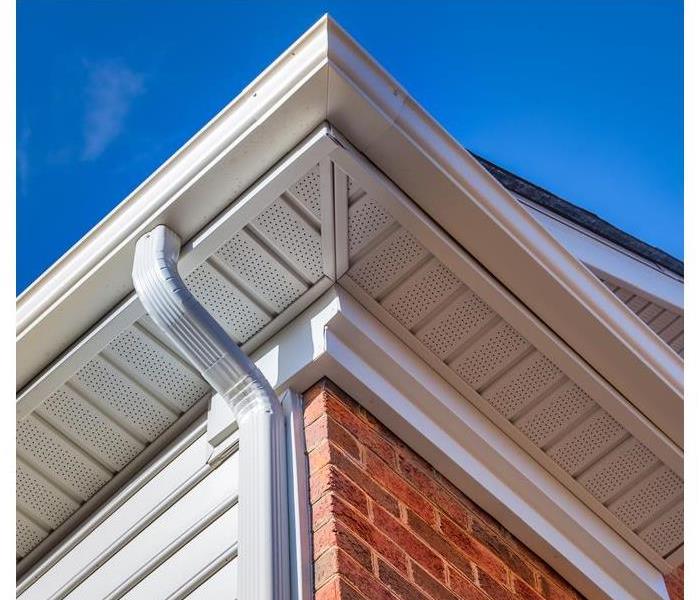 Make sure your gutters and downspouts are clear.
Make sure your gutters and downspouts are clear.
How to Prepare Your Building for Spring
Winter can put a lot of stress on your commercial building in East Conemaugh, PA, so you may be relieved when temperatures start to warm up. That doesn't mean it's time to let your guard down, though. A spring thaw often leads to flooding, which can cause a whole different set of concerns. Make sure your building is ready.
Drainage Cleanup
Melting ice needs a place to go. The key is directing it away from your building so that it doesn't pool at the base and seep into the foundation. Make sure all drainage pathways are clear:
- Gutters
- Downspouts
- Landscape drains
- Trenches
Roof Inspection
Try to schedule a roof inspection as early in the season as possible. Ice and other elements from harsh winter storms can damage the surface, causing weak spots that you may not know about until flooding from runoff causes a leak. A professional roofer can identify these areas before they become a problem.
Frozen Pipe Search
One of the most frequent reasons that business owners have to call water damage restoration experts is to deal with the mess left behind by a busted pipe. Even if you don't notice telltale signs of a water loss such as a slow trickle of water or a surge in your utility bills, call a plumber to inspect your system and make sure everything is in good working order before the first spring flood.
Sprinkler Maintenance
Your outdoor sprinkler system is especially susceptible to damage during a hard freeze. Even if you were diligent to flush it before winter, ice may have formed on the outside of the apparatus. Before you set your watering schedule for spring, check every sprinkler as well as the pipes that supply them for cracks or other flaws.
Flooding is a natural phenomenon at the end of winter. If you know how to anticipate potential problems, you can better prepare your building for the spring thaw.
Getting Ready for Your Insurance Adjuster's Visit After Water Damage
5/23/2022 (Permalink)
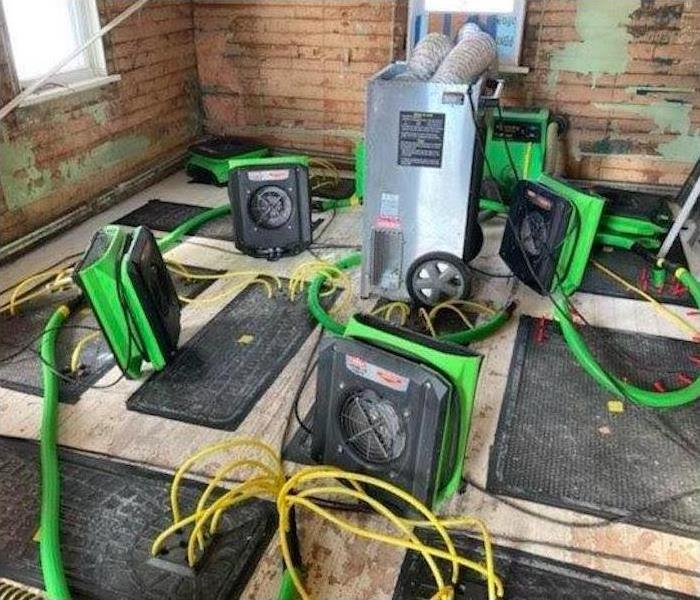 Drying equipment running in a Cresson, PA home.
Drying equipment running in a Cresson, PA home.
Water Damage In Your Home- What To Do?
You've experienced water damage in your Cresson, PA, home. Now, what do you do? After ensuring everyone is safe, it's time to call your insurance company.
What Your Home Insurance Policy Covers
Your agent will review your policy and determine if the damage is covered. Generally, your standard home insurance policy covers water damage from a peril causing sudden, immediate damage, such as:
- Burst water pipe
- Water heater leak
- Roof leak from a storm
It will not cover damage from flooding or poorly maintained plumbing.
Preparing for the Home Adjuster Visit
Your policy has a specified amount of time for you to file an insurance claim. Once you open a claim, your adjuster visits your residence to assess the damage. It's a good idea to prepare for the visit so that it will be productive and efficient.
First, make temporary repairs to prevent further damage. You can hire a contractor to make these fixes or do them yourself. Save your receipts so that you can turn them in as expenses. Your insurance can help you pay for professional water damage restoration.
Remember that because the money you spend on temporary repairs counts toward the amount of your total settlement, you don't want to overspend.
Collect as much information as you can about your damaged belongings:
- A description of the items
- Dates of purchase
- What it will cost to repair or replace the items
Give the information to the home adjuster and any receipts you have.
Find structural damage that you can show the adjuster. You may have damage to walls, floors or ceilings. Your electrical system may also need repairs. If you already have contractor bids, give copies to the adjuster.
Keep copies of all paperwork for yourself: receipts, bids, insurance information, etc.
Water damage is no fun, but preparing for a visit from your home adjuster can help you get through the claims process quickly and easily.
3 Things You Need To Know To Create an Office Fire Escape Plan
5/21/2022 (Permalink)
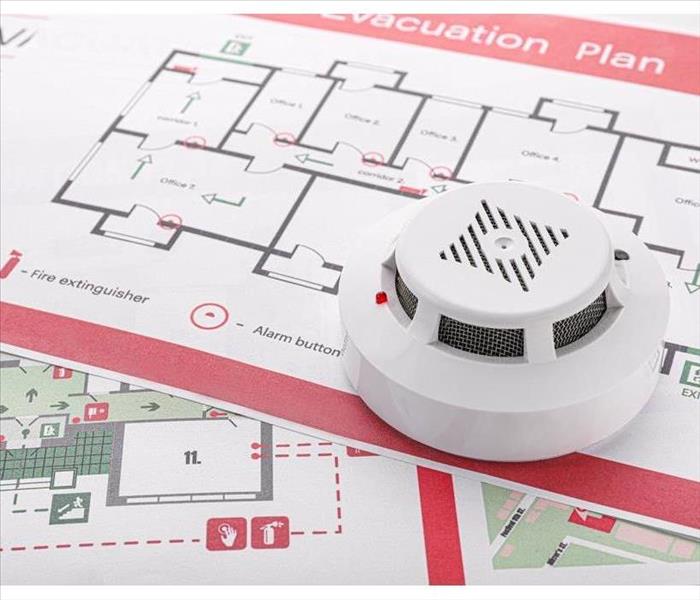 Every office needs to have a fire escape plan.
Every office needs to have a fire escape plan.
Office Fire Escape Plan
An office fire in Portage, PA, can be overwhelming to prepare for, particularly if you don't know where to start. Every office needs to have a fire escape plan to ensure everyone’s safety in the building. The best tool in any emergency is preparedness. Here's how you can start.
1. Prepare for Anything
The first step is to consider different scenarios in which you may need to enact your fire escape plan. By creating multiple escape options, you ensure that safety stays at the forefront of employees’ minds. The emergency evacuation plan needs to include:
- Assigned roles for staff
- Clearly designated escape routes
- Reporting methods
- Emergency contact list
- Shutdown procedures
These five items will provide flexibility while your leaders maintain control over the situation.
2. Define Roles in Your Fire Escape Plan
In an emergency, people are at risk of not knowing how to respond and making small mistakes that can be deadly. Clarity is vital in any emergency escape plan, so it's important to pick leaders ahead of time. The staff needs to know whose orders to follow to avoid confusion. Check that everyone has a list of roles, contact information for the Portage, PA, emergency department and locations of where to gather safely after evacuating.
Depending on the type of business, roles for shutdown procedures should also be included. Note who is responsible for checking that any machines are off, safety protocols are followed and no further risks are created.
3. Plan The Aftermath
After employees evacuate, they need to know where to gather and how to manage cleanup after the fact. When creating an evacuation plan, you need to plan for what happens next. Write a check-in list to guarantee that everyone is accounted for and claims are filed for emergency cleanup services. With a comprehensive plan, your team can stay focused and not panic.
A little preparation goes a long way in ensuring staff safety in a commercial building.
3 Reasons Your Toilet Leaks When You Flush It
5/16/2022 (Permalink)
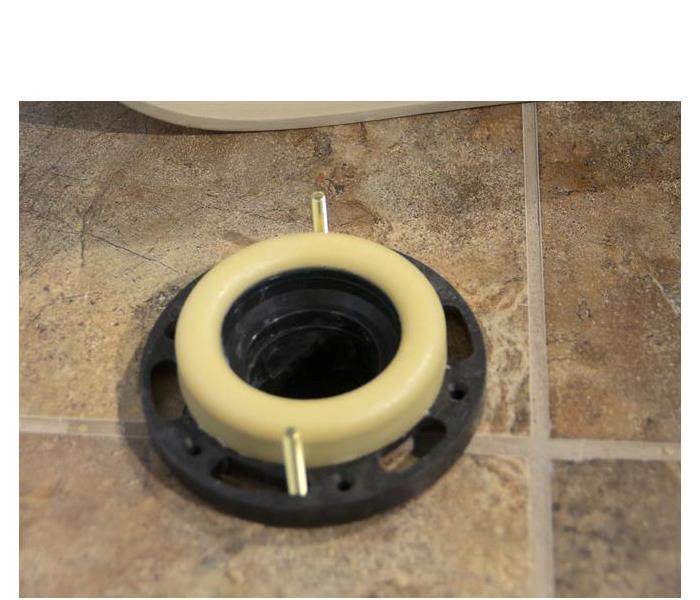 Replace your cracked wax ring with a plastic one to avoid a future bathroom leak.
Replace your cracked wax ring with a plastic one to avoid a future bathroom leak.
Why Does a Toilet Leak When I Flush It?
A leaking toilet is a nuisance. While you might hope to ignore it and hope to repair it at a later date, the longer you let the toilet leak, the more potential you have for immense damage to the bathroom flooring in your Johnstown, PA, home. Here are three reasons your toilet could be leaking when you flush it.
1. Leaking Toilet Flange
The toilet flange is a pipe fitting that secures your toilet to the floor and keeps your seal in place. One common sign of a problem with the flange is that your toilet rocks too much, regardless of how much you tighten the bolts. The type of replacement flange you need will depend on your toilet and what type of flooring you have. You want to choose a flange that allows your toilet to sit flush with the floor.
2. Cracked Wax Ring
Wax rings are designed to last for many years, but they can easily deteriorate and start to crack. Many water damage mitigation specialists recommend replacing your cracked wax ring with a plastic one to avoid a future bathroom leak. The plastic seal lasts much longer than a wax one and isn't as susceptible to cracking.
When you remove the old wax ring, ensure that you completely clean the bottom of the toilet and scrape all traces of wax off of the toilet flange. You want a clean area to ensure nothing interferes with the seal.
3. Loose Tank Bolts
Over time, it's common for the bolts holding the toilet to the floor to wiggle themselves loose. When this happens, the gasket seal isn't as strong as it could be, which can be the cause of your leaking toilet. Verify that the bolts on your toilet have washers on them. While tightening the bolts, have someone else push down on the toilet to ensure you get a tight, secure seal.
Dealing with a toilet leak is an annoyance, but with a few minor fixes, you will find your bathroom back in good working condition in no time.
What Is a Board Up Service and Do I Need One?
4/22/2022 (Permalink)
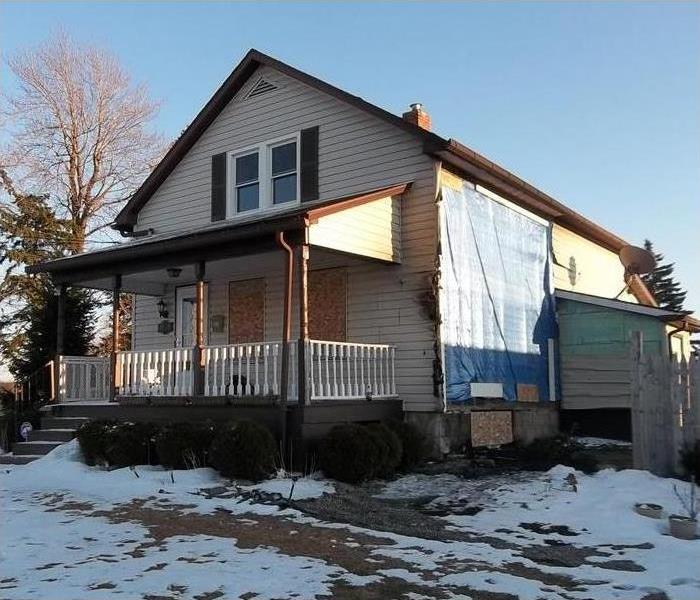 Secure your home with a board-up service after a fire.
Secure your home with a board-up service after a fire.
Is It Necessary to Hire a Board Up Service?
When your home has sustained fire damage in Ebensburg, PA, your first priority is to get your family settled in a safe place, not worry about your damaged home since it will be a while until everything can be repaired. Despite the challenges you're likely facing as you recover from this disaster, properly securing your home is important. One of the first things that will be recommended by a fire damage restoration company is an emergency board-up service. This service is an important part of your home restoration for several reasons.
1. Insurance
Most likely, your insurance company will require that your home is properly sealed between the occurrence of the damage and when the repairs are done. Insurance pays for what is originally quoted, and if more damage is done, you'll have to pay more.
2. Liability
If your home isn't properly secured by a board-up service, anyone who enters your home and gets injured could press charges.
3. Damage
Further damage from weather, animals, or humans makes an already difficult situation worse. Securing your home prevents most additional damage.
4. Property Loss
An open home is an open invitation to people who want what you have. While you may think there isn't much left, anything from appliances to pipes to your HVAC system can be stolen for profit, leaving you to foot the bill.
5. Professionalism
When you trust a company to do the board-up service for you, you can be confident that it will be done correctly. DIY may sound simple, but in addition to being a two-person job, you can cause more damage by improperly placing boards or your efforts simply aren't effective because you're not using the right materials.
Securing your home with a board-up service after a fire is not only recommended by most insurance companies, but you can have peace of mind knowing that your home will be protected until the restoration is complete.
3 Safety Tips During a Thunderstorm
4/13/2022 (Permalink)
 Staying informed on the weather forecast.
Staying informed on the weather forecast.
Tips During a Thunderstorm
Any type of severe weather may pose a threat to your commercial business in Belsano, PA. Especially during a rain storm or thunderstorm, dangers like severe winds and flooding can be a cause for concern. If you own a business, it’s important to know the proper safety techniques during a storm to reduce the possibility of damage and keep yourself and your employees safe.
1. Stay Informed
Staying informed on the weather forecast and possible thunderstorm watches and warnings can be a great way to prevent any damage. Check the forecast daily and check the precipitation percentages. If there is a chance of a storm, stay up to date on the storm’s severity. It’s also important to know the difference between a watch, which means that weather conditions that may cause severe weather are expected, and a warning, which means severe weather has already been spotted by meteorologists. You can tell when a storm is coming if you see puffy cumulus clouds, darkening skies or changes in wind direction.
2. Promote Employee Safety
It’s important to be sure that your employees know what to do during a severe rain storm. Keep policies and procedures for severe weather accessible and make sure everyone knows basic safety tips, such as staying away from windows and refraining from using electric equipment. If possible, refrain from plumbing fixtures that can conduct electricity.
3. Secure Your Building
Before a storm, be sure your building is secured by removing any dead branches or other potential hazards during high winds. It’s also important to make sure any fixtures outside are either taken indoors or put in a place where they will not blow away and cause injury and damage. Make sure all windows and doors are securely shut or locked or they may blow away during the storm.
Rain storms can quickly become severe, so it’s important to be prepared. You can try to avoid damages to your commercial buildings by following these safety tips.
Mold: What It Is, and How To Eradicate It
4/5/2022 (Permalink)
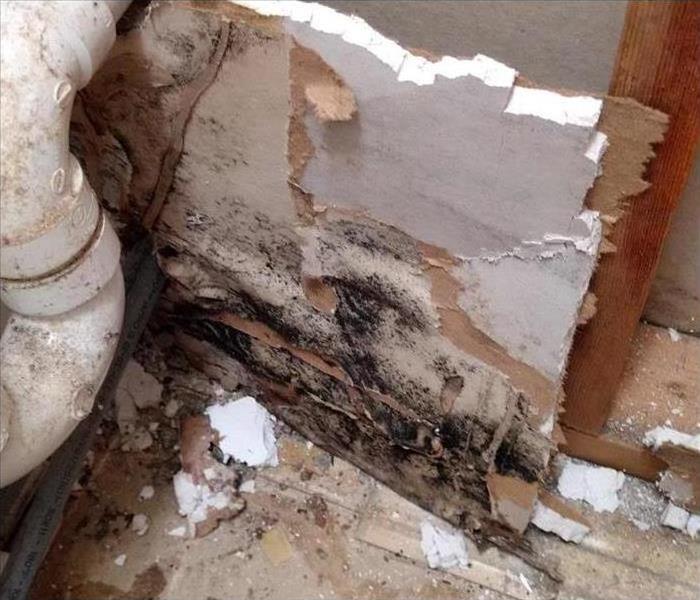 Mold growing on wet walls.
Mold growing on wet walls.
How Mold Grows and Spreads
Fungi are everywhere. When it takes the form of black mold in your Vinco, PA, property, it is an unwelcome guest that may easily run rampant if not immediately addressed. No matter how well you maintain your property, even a small moisture problem may lead to an infestation. These pesky microorganisms only need a few simple ingredients to flourish: moisture, warmth and food. Once they have those, a potentially endless life cycle begins.
Life Cycle
Whether it is black mold or mildew, there are four main phases of the life cycle.
Hypha Cell: This tiny thread-like cell starts feedings on organic material, such as drywall and wood, via releasing enzymes. After absorbing enough nutrients, it grows into a mycelium and forms hyphae clusters.
Spore Formation: Some of the hyphae cells start to develop spores on the ends. The spores will only grow if the conditions are right, including enough oxygen, light and nutrients.
Spore Dispersal: Once formed, they become airborne in search of a new place to start the growth process. Although minute, they are hardy and may even stay dormant for years.
Spore Germination: Once at a new location, the spores wait for the perfect environment to begin the process again.
Proper Cleanup
Since spores are always present, ensuring they don’t flourish means staying on top of water damage and other moisture problems. If not caught soon enough, the mold cleanup process is often daunting and requires high-tech tools and techniques to completely eradicate. A quick wipe-down with commercial products may clean the surface, but they won’t kill fungi. In some cases, the water in cleaners may benefit their growth. When faced with this type of damage, it is often best to contact a mold remediation and restoration specialist. Along with having the right gear, the right company will be certified in cleaning and restoring your property.
Black mold is always lingering, but it doesn’t have to turn into a big problem. Understanding how it grows and spreads makes it easier to develop a prevention plan.
Avoid These 3 Causes of Sewage Backup
3/28/2022 (Permalink)
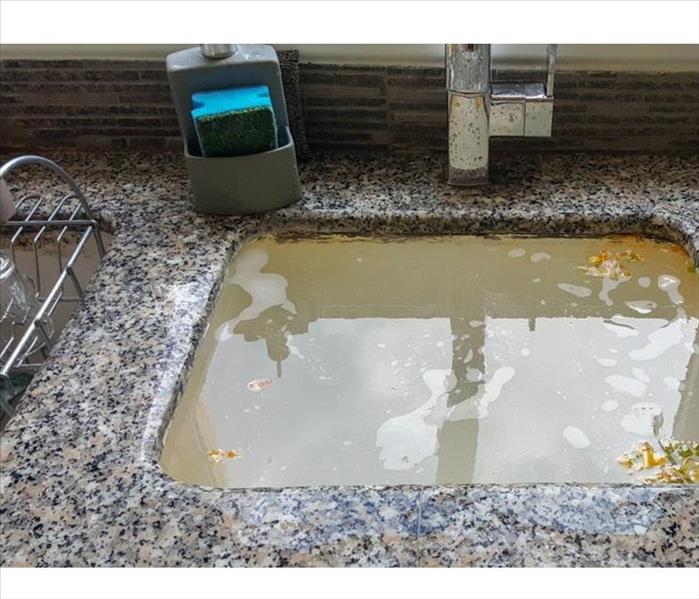 Pipes can get clogged when solid substances are thrown into sinks.
Pipes can get clogged when solid substances are thrown into sinks.
Three Possible Causes Of Sewage Backup
If you are a homeowner in Gallitzin, PA, whose house has suffered damage from a backed-up sewer, one of the biggest impact areas will likely be your basement. A flooded basement can be inconvenient and expensive to deal with, so putting in measures to prevent such an occurrence is highly advisable. Here are three possible causes of sewage backup to keep in mind.
1. Sewage Overflow
Sewage systems are designed to have a maximum water-holding capacity. Thus, when there is a heavy downpour and the amount of water coming in exceeds the capacity of a sewer, there is a high likelihood of flooding even though the system may be in perfect working condition.
2. Old Sewage Systems
The average age of many public sewage systems in the U.S. is 30 years. As a result, many of them are more susceptible to damage now than in the past. This means that if your home in Gallitzin, PA, is connected to any such public system, there is a bigger risk of suffering a flooded basement. Similarly, if you live in an older home, your plumbing may be nearing the end of its life span. Replacing old pipes and valves before they deteriorate can prevent a backup of sewage.
3. Blocked Pipes and Drains
When foreign materials get into drains and pipes, it can result in water backing up and, ultimately, flooding. Pipes can get clogged when solid substances are thrown into sinks, flushed down toilets or washed into drains from the outside. To keep your pipes and drains clear, be sure to get rid of oil and grease properly. You should also take care not to use toilets and sinks to dispose of items that do not easily degrade.
A flooded basement can cause a lot of anxiety and discomfort to a homeowner. If you find yourself surrounded by unwanted water, consider consulting a reputable water damage restoration company to help.
Tips for Preventing a Fire Disaster at Your Commercial Property
3/23/2022 (Permalink)
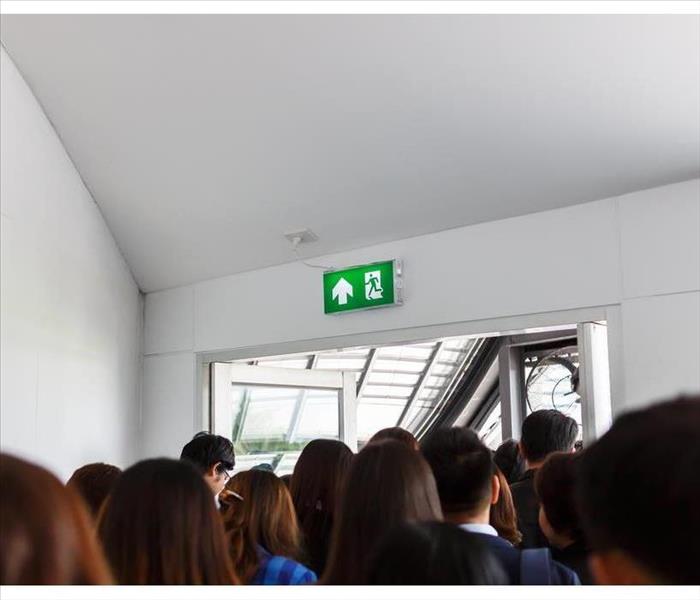 Fire preparation should also include your employees.
Fire preparation should also include your employees.
Fire Preparation Tips
Nobody wants a fire to happen to them in Summerhill, PA, especially if it affects their livelihood. So it is in your best interest to do what you can to reduce the likelihood of such an event and to implement fire preparation policies in case it does happen to you.
Risk Analysis
A good place to start is to identify where a fire is most likely to come from in your building and then target most of your disaster preparation in that area. You can also shore up your insurance to cover the types of damage you think it might incur. You should research the appropriate fire remediation services so that you don't have to worry about that after the fact. Some common fire sources are:
- A kitchen or a grease fire
- Electrical outlets
- Wildfires in your area
Develop an Emergency Plan
To mitigate the damage a fire can cause, fire preparation should also include your employees. You should choose an evacuation route and train employees regularly in their specific roles during an incident. So that everyone's lives aren't put on hold, you can come up with a plan for how to continue to run the business during the recovery period.
Protect Your Assets
To keep your fire damage losses to a minimum, you should back up all your important documents and files to a remote server or database. You could also consider keeping certain valuable equipment and materials at separate locations. It would be a good idea to maintain an updated inventory of all company property along with proof of each item's value.
It is always better to be safe than sorry when it comes to fire preparation. Although it can sometimes be inevitable, it is smart to do your best to prevent it from happening to your commercial property and have a plan in place should it occur anyway. As the scouts say, be prepared!
Top 3 Causes of Water Loss
3/7/2022 (Permalink)
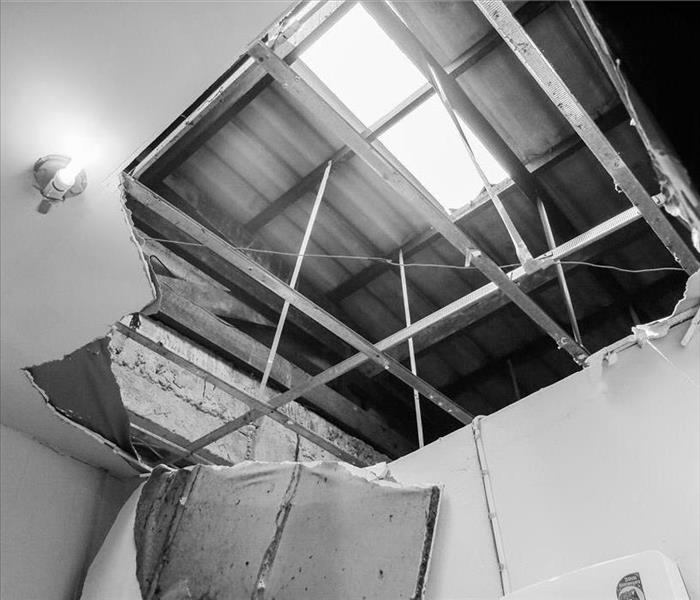 The ceiling was damaged due to a roof leak.
The ceiling was damaged due to a roof leak.
Common Causes of Water-Related Losses for Businesses
Damaged pipes in your East Conemaugh, PA, business and having to hire water remediation professionals can rain on your parade. Not only will you lose time that you could be working, but you will also have to replace valuable equipment and inventory. This can result in a lot of loss for your business. Here are some of the common causes of water-related losses for businesses and how to avoid them.
1. Equipment
Any equipment that uses water is putting your business at risk since it uses potentially damaged pipes. HVAC units, water heaters, and any other appliances in your business all have pipes that can leak. If leaking pipes occur when your company is closed, you can come back to find some serious damage. To avoid this type of damage, you need to perform regular maintenance on your equipment. Notice any rust, cracks, or bulges in your pipes as these are signs of moisture. Also, be sure to replace your water lines regularly. Then, recaulk and reseal the hoses to prevent issues and loss.
2. Roof Leaks
The only thing worse than damaged pipes is a roof leak. If you find a pond on your roof, you have a drainage problem. This is literally weighing down on your business. Over time, your roof will buckle under the strain and start to leak. To avoid roof leaks, regularly check your flashing, roofing, and drainage. If these become clogged or deteriorate, you are setting yourself up to experience serious loss.
3. Plumbing Issues
Your plumbing system can experience clogs and other damage. Cracks are a serious problem that can lead to leaks and excessive loss. To avoid serious issues, check your pipes regularly for stains, rust, cracks, and bulges. Also, perform regular maintenance to avoid clogged pipes that can lead to serious losses.
Any business is at risk of loss due to flooding and water damage. Fortunately, there are measures you can take to avoid water-related losses.
How to Tell When Your Dryer Vent Needs Cleaning
2/28/2022 (Permalink)
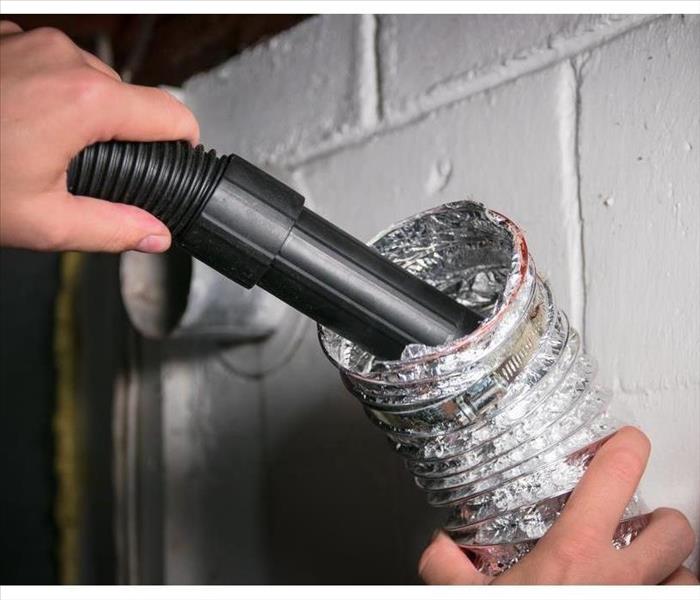 It's time to clean out your dryer vent.
It's time to clean out your dryer vent.
Prevent a Dryer Fire
If you own a home in Carrolltown, PA, fire safety is probably something you think about often. You've probably installed smoke detectors and have an extinguisher handy in case of a mishap. But have you taken a look at the vent on your dryer recently? Every year, thousands of homes are damaged due to the occurrence of a lint fire. Luckily, it's easy to tell when it's time to clean out your dryer vent. So, what should you look for in order to prevent a dryer fire?
1. There's a Burning Odor
A good indication that the vent needs cleaning is a burning smell. If lint is clogging up the drum casing, exhaust tube or trap, you could easily have a lint fire. When there's a burning odor coming from the dryer, turn it off and call a professional to service it.
2. Clothes and Dryer Are Both Very Hot
If the dryer is extremely warm when you touch the outside and your clothes feel really hot when you remove them, it's probably a blocked vent. When the vent is blocked, the hot air can't escape from the dryer.
3. Clothes Are Taking Forever to Dry
With a blocked vent, clothes might take up to three times as long as normal to get dry. When you put your clothes in for a regular cycle, you might find that they're still damp when you take them out. When the vent is blocked, it can't allow moisture to be released from the dryer.
4. Your Dryer Hasn't Been Inspected for a While
A vent cleaning professional should take a look at your dryer at least once a year. While you can certainly clean out the vent by yourself, hiring a professional will ensure that the job is done right, since they will have the right equipment to do a thorough cleaning and make sure the dryer in a safe condition for use.
The last thing you want is a lint fire in your home. By looking out for the obvious signs, you can be sure to prevent it from happening.
SERVPRO Fire Restoration
2/23/2022 (Permalink)
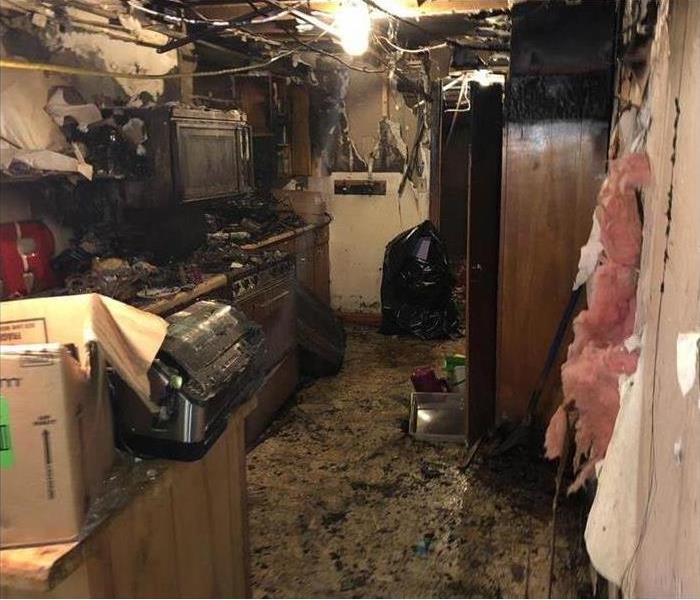 Fire damage in a Cresson, PA home.
Fire damage in a Cresson, PA home.
After a residential fire, insurance teams need to have a plan in place to deal with the fire, smoke and water damage left in the aftermath of flames and firefighting. SERVPRO’s fire restoration team can help get a home back to its original state after such a disaster.
Fire Rebuilding Services
SERVPRO is proud to be a one-stop shop for residential mitigation and restoration needs. The steps that rebuilding technicians will take to restore a Cresson, PA, home after a fire will generally include the following:
1. Emergency Dispatch - A simple call to a SERVPRO 24-hour National Call Center will lead to a quick dispatch of a highly prepared restoration professional in most cases.
2. Inspection and Assessment - After arrival on the scene, SERVPRO technicians will evaluate and test the property to determine the extent of the fire damage and prepare a fire restoration plan.
3. Board-Up and Tarping - After surveying all damage to a home, SERVPRO technicians can secure damaged windows, walls and roofs with boards and tarps to defend against further damage and unwanted entry.
4. Immediate Water Damage Cleanup - Water removal will clean up the majority of any firefighting water that is present, and will be followed by the use of air movers and dehumidifiers for an even more thorough dry out.
5. Soot and Smoke Removal - SERVPRO technicians are able to use high-tech equipment and special methods to eradicate smoke from all household surfaces.
6. Fire Cleaning - The cleaning and sanitizing step of the fire restoration plan involves the utilization of advanced cleaning and deodorizing processes to restore surfaces and belongings.
7. Restoration - This final step involves minor repairs, paint jobs and even some major repairs in order to get a home back to its original condition.
Keep in mind that every fire rebuild situation varies, but the steps above will be what dedicated technicians use in the vast majority of situations to get a home back in shape as quickly and thoroughly as possible. Once SERVPRO is done working its magic on a fire-affected home, it will look “Like it never even happened.”
Operating a Business in a Flood Zone: Understanding City Flood Barriers
2/16/2022 (Permalink)
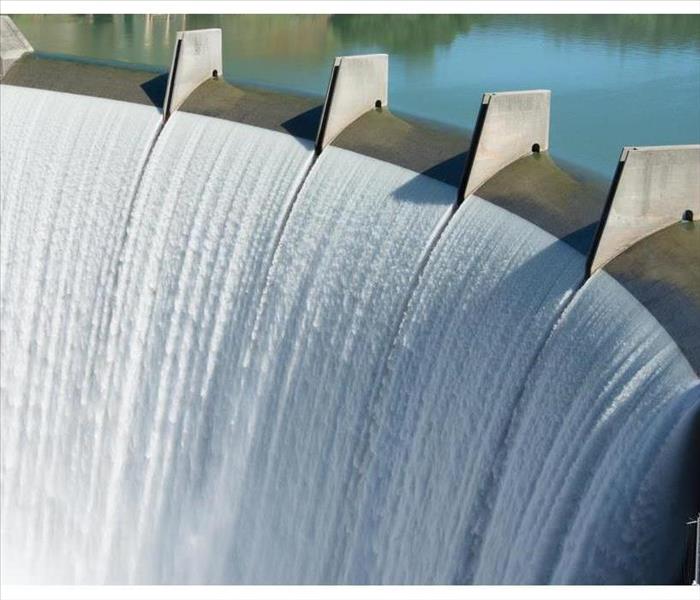 One of the most common tools to stop flooding is dams.
One of the most common tools to stop flooding is dams.
Operating a Business in a Flood Zone
Before opening a business in a high flood zone area, it is wise to investigate the tools and methods a city uses for flood prevention, preventing high water levels from potentially enveloping your business. While not every town uses every tool, it is still beneficial to know.
1. Dams
One of the most common tools to stop flooding is dams. Dams are large structures that help to restrict underground streams and water. These barriers are among the most popular means of flooding control because they can also be used to divert water for drinking, irrigation, industry and navigation.
2. Sluices
A sluice gate is often used to prevent high water levels. Essentially, these gates help to regulate the flow of water, and in essence, control the output to minimize the risk of flooding. The gate is kept closed when water levels are fair and opened when the water pressure is too great.
3. Locks
Water locks are used to control water levels within canals. A lock consists of a channel with two gates. Behind one gate is a higher water level than the other, allowing the water level within the channel to be manipulated.
4. Dikes
A dike is another type of barrier. However, unlike a dam, a dike is made of earth and stone and acts as more of a natural barrier between land and water. Dikes became popular in the Netherlands and eventually gained popularity in the states.
While it is nice to know what kind of flood prevention a city takes, it is more important that you have adequate insurance coverage for your business and an emergency response plan through a disaster restoration specialist in the Portage, PA, area. Being prepared is not only up to your city.
Most cities situated in a flood zone go to great lengths to protect their citizens from high water levels. If you decide to operate out of a flood zone, then you should be aware of these measures while also ensuring your own interests by purchasing flood insurance and making a plan for potential disaster.
How To Create a Fire Escape Plan
1/29/2022 (Permalink)
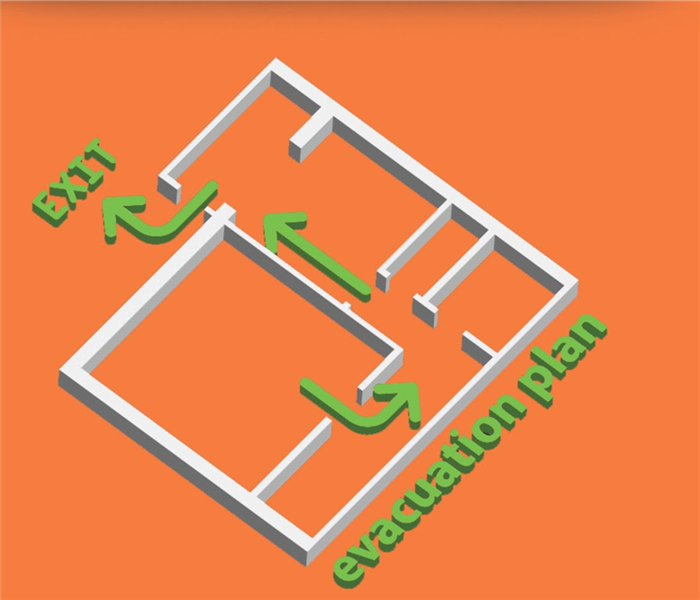 Every family should have a fire escape plan.
Every family should have a fire escape plan.
How to Make a Fire Exit Plan
Disaster and calamity can strike your home at any time. No matter how diligently you prepare, you can’t always prevent accidents and mishaps such as fires. It is possible, however, to be ready to get out of your home safely if a fire starts. Every family should have a fire escape plan. If you haven’t developed one yet, there are resources to help you. Once you’ve created and practiced your emergency escape plan for your home in Johnstown, PA, you can have peace of mind.
1. Meet and discuss what you’ll do in case of an emergency. The nature of emergencies is they often come with little or no warning. To help prevent major injury or death, you must be prepared to act immediately. To begin your fire escape plan, meet with the members of your family and talk about things such as what emergency alerts you have in the home and which ones you need; what the best route is out of the home and where you will go once you’re safely outside.
2. Evaluate your specific needs. Every family is different, so your emergency escape plan won’t be like the next person’s. Consider the ages of those in your family and think about physical limitations anyone may have. Include pets in your plan as well. Give every family member an assignment.
3. Practice your escape. If you practice your plan, chances of success are better in the real event. Time how fast you can get out of your home and to your safe spot. Then, work on shaving the seconds off that time. The more you practice, the more confident and comfortable everyone will feel.
A good fire escape plan from your home in Johnstown, PA, will help minimize the confusion and panic if a real fire occurs. If you need help with your emergency escape plan, the American Red Cross has some excellent resources.
How to Keep Pipes from Freezing When the Temperature Drops
1/29/2022 (Permalink)
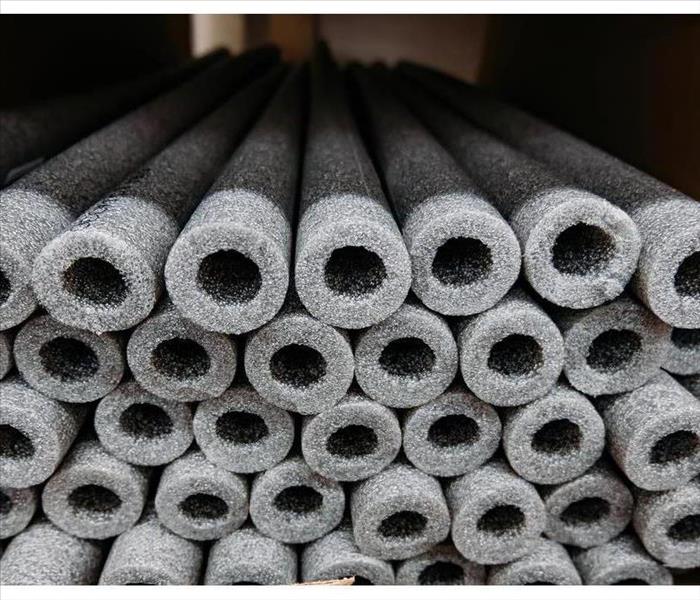 Make sure to insulate your pipes.
Make sure to insulate your pipes.
Prevent Your Pipes From Freezing
When the temperature drops in Portage, PA, you probably remember to protect yourself and your loved ones, but have you remembered to protect your home? Unless you’ve taken necessary precautions, cold temperatures can cause pipes to freeze. This is a problem for two primary reasons:
- Frozen pipes prevent the flow of water.
- Pipes that are frozen can eventually burst, making water line repair necessary.
It is important to remember that all types of pipes can freeze, including copper, plastic, and steel. The following tips will help you prevent your pipes from freezing.
Turn on the Heat
Everyone knows that leaving the heat on makes for an expensive heating bill, but that heating bill can be a lot cheaper and less of a pain than frozen pipes that burst and cause flooding. While you might want to tough out the cold with a down comforter and mittens, your pipes need to stay warm, so keep the heat set no lower than 55 degrees Fahrenheit.
Open the Cabinets
Turning on the heat won’t help much if your pipes are hidden away in heavy cabinets. Prevent pipes from freezing by opening cabinet doors where there are pipes to allow heat to circulate around your pipes. It might not look as nice to have everything open, but you’ll be happy when the pipes don’t freeze.
Insulate Pipes in Unheated Areas
If you have pipes in unheated areas of the house, like the garage or crawl spaces, or against uninsulated outside walls, make sure to insulate those pipes. Heat tape can be useful, but make sure to read the directions so you know whether you will need to manually plug and unplug the tape to heat the pipes, or if it will regulate temperature automatically. You can also add extra insulation in the form of foam rubber or fiberglass sleeves.
When freezing temperatures come to Portage, PA, make sure to protect your home from frozen pipes. If your pipes do freeze and burst, a SERVPRO professional can help with the cleanup.
Assessing Flood Damage After a Rainstorm
1/4/2022 (Permalink)
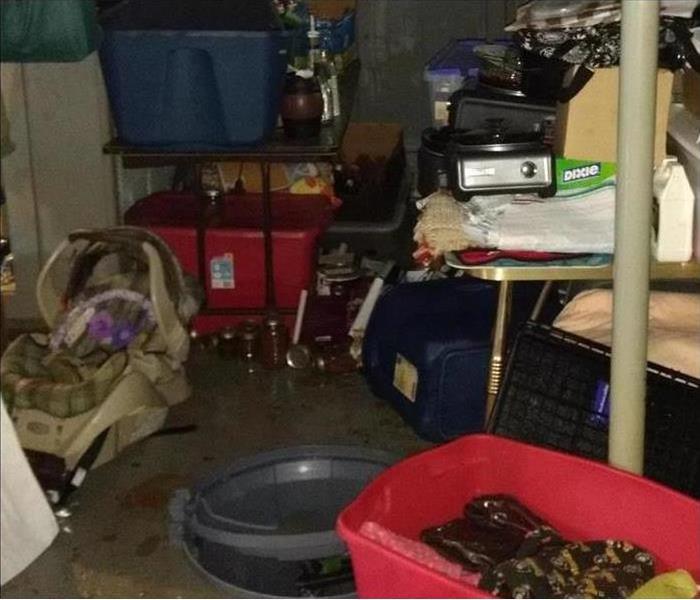 A rainstorm caused this basement to flood.
A rainstorm caused this basement to flood.
After a Rainstorm, Evaluate Flood Damage
Heavy rainstorms around Ebensburg, PA, have caused many homes to experience flooding, which can transport dangerous microorganisms into your residence. Unlike damage from a broken pipe or leaky appliance, floodwaters pick up bacteria and germs from outdoors and deposit them inside. Long after a storm has passed, leftover water and humidity linger behind in absorbent and porous materials. Determining the source of water in your home is an important step in the restoration process.
Understanding the Three Categories of Water Damage
Each water category requires a different cleaning and restoration procedure. The most important thing to determine is whether the water originated from inside or outside the residence. All damage caused by flooding from rainstorms is considered category 3.
• Category 1 and 2: Water from a source inside the home, such as a leaky pipe or appliance.
• Category 3: Water from an outside source that is brought into a residence and causes flood damage. This category can introduce a variety of contaminants into a home. Floodwaters have oftentimes been in contact with harmful elements, such as sewage, that may harbor dangerous microorganisms.
Starting the Cleaning and Restoration Process
After determining the category, the next step is contacting a qualified professional service that has the proper equipment and skills to handle water damage.
• Cleaning Category 1 or 2: Using extractors, experts should remove any water from saturated areas. Affected walls and baseboards would be removed and vent holes drilled to allow airflow. Fans and dehumidifiers should be strategically placed throughout the area to decrease humidity. Any category 2 damage would also include carpet disinfection.
• Cleaning Category 3: Contaminated areas should be isolated, and all remaining water removed. Nonabsorbent materials should be disinfected. After the decontamination, the rest of the procedure follows the same steps as a category 1 or 2 cleaning.
Dealing with flooding situations is never fun. However, with the help of qualified professionals, your home can be decontaminated and restored safely, quickly and correctly.




 24/7 Emergency Service
24/7 Emergency Service




























